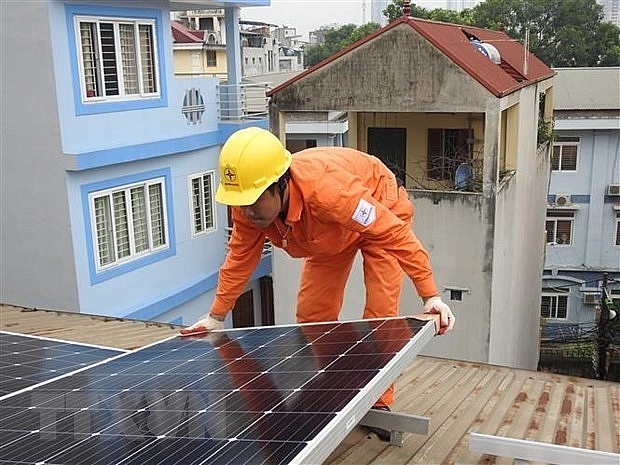Renewable energy yet to meet potential: conference
 |
| Illustrative image (Photo: VNA) |
Speaking at the conference on renewable energy and roof-top solar power held on July 9 in HCM City, Deputy Minister of Industry and Trade Hoang Quoc Vuong pointed to many barriers that have hindered solar and wind power development.
Infrastructure for the energy transmission grid, for instance, has not kept pace with renewable energy projects.
As a result, several projects in Ninh Thuan and Binh Thuan cannot generate 100 percent of capacity at certain time, the Deputy Minister said.
Roof-top solar power also has high initial costs, and while products and services related to roof-top solar power are available, they have no specific technical standards. This has affected the interest of investors in such projects.
Vuong noted that the Government has created preferential policies that offer favourable conditions for investors to exploit the potential of renewable energy for sustainable socio-economic development.
The ministry has also set up action programmes, which have been submitted to the Prime Minister for approval, that would be the legal basis for implementation of such projects, Vuong added.
Since the issuance of the governmental decision on preferential policies for solar power development in April 2017, around 4,500 MW of power has been connected to the grid.
Nearly 500 MW of roof-top solar power and more than 400 MW of wind power systems are operating. About 3,000 MW of solar power and 2,000 MW of wind power systems are under construction and are expected to be operating by the end of this year.
These solar and wind power systems will reduce pressure on the national electricity system and help set up a renewable energy market in the country, contributing to local socio-economic development, Deputy Minister Vuong said.
Vo Quang Lam, deputy General Director of Vietnam Electricity (EVN), said that energy demand continues to grow. The demand in the 2016-20 period increased by 0.3 percent to 11.3 percent per year. From 2021 to 2030, it is estimated to rise by 8 percent to 8.5 percent each year.
According to the Electricity and Renewable Energy Authority, the country will lack 12,690 MW of power by 2023.
A shortage of power could occur in the southern region, with 3.7 billion kWh in 2021, increasing to nearly 10 billion kWh in 2022 and 12 billion kWh in 2023.
What the stars mean:
★ Poor ★ ★ Promising ★★★ Good ★★★★ Very good ★★★★★ Exceptional
Related Contents
Latest News
More News
- Heavy industries set for pilot greenhouse gas quotas (December 25, 2025 | 10:00)
- Swedfund invests in MSME growth and climate action in Vietnam (December 19, 2025 | 11:42)
- GreenYellow brings solar energy to light up remote schools in Tuyen Quang province (December 19, 2025 | 08:00)
- Charge+, Grab partner to develop EV charging network in Vietnam (December 18, 2025 | 17:11)
- Linking sci-tech and innovation to Vietnam’s net-zero future (December 18, 2025 | 14:31)
- Driving double-digit growth through green and circular transformation in Vietnam (December 17, 2025 | 09:00)
- Standard Chartered and ACCA deepen collaboration to develop Vietnam’s talent for a sustainable future (December 15, 2025 | 18:18)
- Schaeffler reports strong early output from Dong Nai solar project (December 12, 2025 | 15:16)
- Forestry conference highlights biodiversity and sustainability goals (December 09, 2025 | 13:35)
- Home Credit honoured among top 10 sustainable companies in trade and services (December 09, 2025 | 12:18)

 Tag:
Tag:



















 Mobile Version
Mobile Version